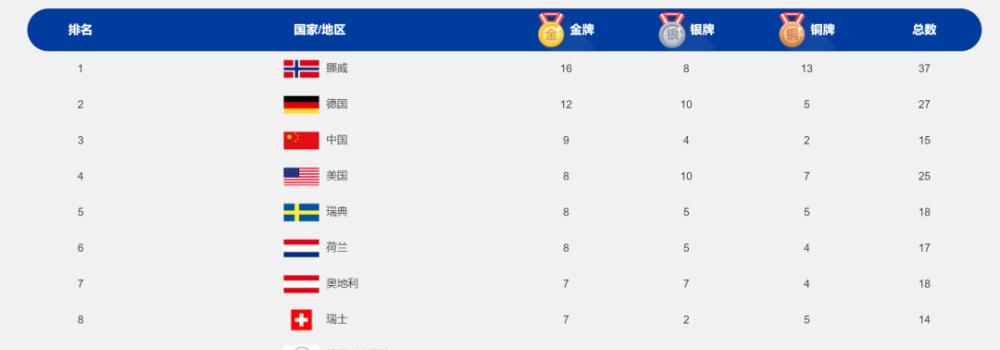With finland winning the men's ice hockey championship, the Beijing Winter Olympics came to an end, with 109 gold medals going to their masters, and the gold medal list and medal table were settled. Norway again topped the gold medal list after the PyeongChang Winter Olympics, and 16 gold also set a record of 14 gold in a single Winter Olympic Games held by him. At the second place in the gold medal list is the German team that won 12 gold medals, Norway and Germany constitute the "top two" camp of the Winter Olympic gold medal list; China and the United States, Sweden, the Netherlands, Austria, Switzerland, the Russian Olympic Committee, France and other teams that achieved the best record of 9 gold in history constitute a huge second camp, and the pattern of "two super and many strong" has been formed.

Image source CCTV
The status of the two powers has not changed
Olympic Winter Games
Cross-country skiing is Norway's most powerful "weapon" among the strong teams of the Winter Olympics, and before the Beijing Winter Olympics, they have won 47 gold, 42 silver and 32 bronze in the event, with a gold medal contribution rate of 32%. In this Winter Olympics, under the leadership of the famous player Johaiyuga, the Norwegian team once again won 5 cross-country skiing gold medals, stabilizing the "basic set". In addition, in the old rival Germany's "fist event" winter biathlon, The Norwegian soldiers also performed well, scoring 6 gold, while the German team, which has won 19 winter olympic biathlon gold medals in history, only won 1 gold this time. Fortunately, the German team continued to be strong in the bobsleigh project, and won 9 golds.
Norwegian athlete Johaig Wei Zheng, who won the gold medal in the women's 30 km collective departure of cross-country skiing, was photographed
Since the 1980 Winter Olympics, the gap between the first and second places in the Winter Olympic gold medal list has been very small, basically between 1 and 2, and even the number of gold medals has been equal, to compare the silver medal situation, only the first Canadian team in the 2010 Vancouver Winter Olympics gold medal list has an advantage of 4 points ahead of the second place Germany team. The gap between the top two in this competition has reached 4 again, indicating that Norway's position as the world's no. 1 ice and snow team has been further consolidated.
The second camp has its own characteristics
"Ice strength and snow weakness" was once an inherent impression of the outside world's ice and snow sports on the mainland, but since the successful bid for the Beijing Winter Olympics, the mainland ice and snow athletes have tasted snow and made up for shortcomings, and at the same time, through cross-border cross-border material selection, scientific and technological assistance, etc., the goal of "participating in the whole project" has been realized, and the strength and competitiveness of ice and snow projects have been greatly developed. In this Winter Olympic Games, the ratio of 9 gold medals to ice and snow on the mainland reached 4 to 5, forming a good situation of "double flying" on ice and snow, compared with the second camp, which is either mainly on ice or mainly on snow, the pattern of ice and snow sports on the mainland has entered a new stage of benign development.
Closing ceremony Members of the Chinese Winter Olympics delegation entered the ceremony by Wei Zheng
The fourth-placed U.S. team's 8 gold mainly relies on snow sports, mainly on emerging fashion projects such as freestyle skiing and snowboarding. The Swedish team, which also has 8 gold, also won 5 gold in the snow project. Another 8 gold winner, the Dutch team, won 6 gold in speed skating and 2 gold in short track speed skating, all from ice, and West, who participated in the Winter Olympics five times, set a record for the number of medals for active athletes in the Winter Olympics with 13 medals. The situation is similar for the Austrian and Swiss teams with 7 gold, and the Russian Olympic Committee and France teams with 6 gold. It is worth noting that the number of silver medals in the Russian Olympic Committee team reached 12, and there were also 14 bronze medals.
The asian team as a whole is stable
Affected by geographical factors, ice and snow projects have been mainly popular in Europe and the Americas in the northern hemisphere. In recent years, with the maturity of artificial snowmaking and ice making technology, Oceania countries in Asia and the southern hemisphere have also won in the Winter Olympic Games.
In addition to the Japanese team, which won 1 gold by speed skating leader Miho Takagi, 2 golds were also recorded in the snow field, and the other 6 silver medals were also very impressive.
Women's 1500m gold medalist Miho Takagi from Japan Photo by Ho Somun
The "fist project" of the Korean team is short track speed skating. Before the Beijing Winter Olympics, 24 of the 31 Winter Olympic gold medals of the South Korean team came from the short track. At this Winter Olympics, the two gold medals of the Korean team also came from the short track.
Thanks to the good tradition of extreme sports, in the past two years, Australia, New Zealand as the representative of the southern hemisphere countries in the freestyle skiing, snowboarding have gained, this Winter Olympics New Zealand team 2 gold (this is also the first time in New Zealand's history to win gold medals, into the Winter Olympics medal table), Australia team 1 gold are through the "extreme sports gene" project obtained.